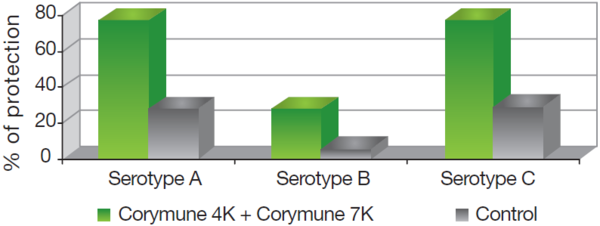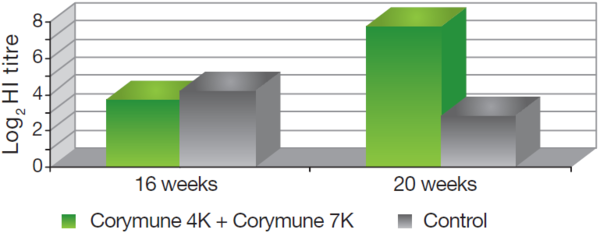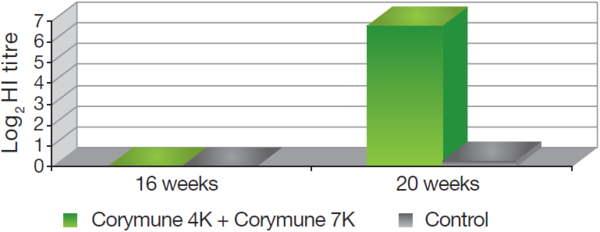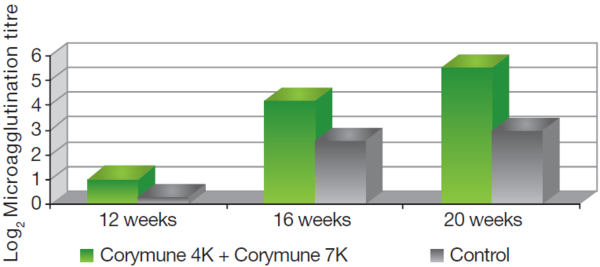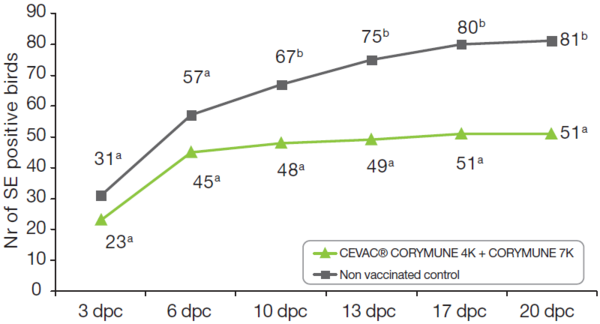...
--> Introduction
--> CEVAC® CORYMUNE 4K & 7K: Benefits Beyond Protection
--> Conclusion
CEVAC® CORYMUNE 4K & 7K - BENEFITS BEYOND PROTECTION -
By Dr Marcelo PANIAGO - Regional Market Manager – Poultry, Ceva Animal Health Asia Pacific
.
INTRODUCTION
Preventing losses due to common diseases such as Infectious Coryza (IC), Newcastle Disease (ND), Egg Drop Syndrome (EDS) and Infectious Bronchitis (IB) has been a constant challenge for the poultry industry. More recently, concerns related to Salmonella Enteritidis (SE*) have increased worldwide and its prevention has become a major issue for egg producers and breeder farmers.
Basically, biosecurity and vaccination are the tools used for the prevention of all these aforementioned diseases. However, most of the vaccines are applied separately and therefore extra handlings of the pullets are necessary. Consequently, it increases the cost of vaccination, builds up the stress and, more importantly, it can affect the growth of the pullets which will negatively impact the flock performance. For these reasons, the modern poultry industry requires more convenient solutions against these diseases.
* SE = Salmonella enterica subspecie enterica serovar Enteritidis
.
CEVAC® CORYMUNE 4K & 7K: BENEFITS BEYOND PROTECTION
Ceva Santé Animale developed a unique and innovative combination of vaccines to prevent all these major diseases which cause economic losses to the egg industry: CEVAC® CORYMUNE 4K and CEVAC® CORYMUNE 7K.
CEVAC® CORYMUNE 4K is an inactivated vaccine which contains the serotypes A, B and C of Avibacterium paragallinarum (formerly known as Haemophilus paragallinarum) and Salmonella Enteritidis (SE) in aluminum hydroxide adjuvant and it is used for prime vaccination.
CEVAC® CORYMUNE 7K is also an inactivated vaccine containing the serotypes A, B and C of Avibacterium paragallinarum, SE, ND, IB and EDS in oily adjuvant and it is used for booster vaccination.
^ Top page
.
Trial 1
Commercial layer type pullets were vaccinated with CEVAC® CORYMUNE 4K at 12 weeks and revaccinated with CEVAC® CORYMUNE 7K at 16 weeks of age. Three weeks after this booster vaccination (19 weeks of age), the chickens were challenged with serotypes A, B and C of Avibacterium paragallinarum and observed during one week for clinical signs of the disease.
The results are presented in the Graphic 1.
Graphic 1 Protection Against A, B & C of Avibacterium paragallinarum Challenges
These results show a very high level of protection induced by the combination of CEVAC® CORYMUNE 4K and CEVAC® CORYMUNE® 7K against challenges of three serotypes of Avibacterium paragallinarum.
At 16 and 20 weeks of age, serology (Haemagglutination Inhibition) for ND, IB, EDS was carried out. In the same way, at 12, 16 and 20 weeks of age, a serological test (Microagglutination) for SE was performed.
The results are expressed in Graphic 2, 3, 4 & 5.
Graphic 2 Antibody Response Against Newcastle Disease
Graphic 3 Antibody Response Against Infectious Bronchitis
Graphic 4 Antibody Response Against Egg Drop Syndrome
Graphic 5 Antibody Response Against Salmonella Enteritidis
All these serological results show a consistent and high seroconversion against NDV, IBV, EDS and SE which correlates with protection against these diseases.
^ Top page
.
Trial 2
A very comprehensive trial was carried out in an independent laboratory in Brazil (FCAV-UNESP – State University of São Paulo, School of Agricultural and Veterinary Sciences Jaboticabal Campus, Department of Veterinary Pathology Avian Pathology Laboratory) in order to assess the efficacy of the combination of CEVAC® CORYMUNE 4K and CEVAC® CORYMUNE 7K against a heavy challenge of Salmonella Enteritidis.
In this experiment, commercial layer type pullets were vaccinated with CEVAC® CORYMUNE 4K at 5 weeks and revaccinated with CEVAC® CORYMUNE 7K at 9 weeks of age. Three weeks after this booster vaccination (12 weeks of age), the chickens were challenged with approximately 1.2 x 108-9 CFU/ml SENalrSpcr (Salmonella Enteritidis strain resistant to nalidixic acid and spectinomycin) by oral route (2 ml). The chickens were monitored for 3 weeks and cloacal swabs were taken at 3, 6, 10, 13, 17 and 20 days post challenge (dpc).
These results, expressed in the Graphic 6, undoubtedly show that pullets vaccinated with CEVAC® CORYMUNE 4K and CEVAC® CORYMUNE 7K had a significant decrease of SE in the faecal contents. Consequently, it indicates a substantial reduction on environmental contamination by these bacteria.
Graphic 6 Cumulative Amount of Birds SE Positive on Cloacal Swabs at Different Days Post Challenge
Numbers with different letters in the same dpc are statistically different (p<0.05)
^ Top page
.
CONCLUSION
Even though the use of vaccines is compulsory in protecting chickens against undesirable diseases, the vaccination procedure is always stressful for the flock. Moreover, any unnecessary handling of the chickens can have negative impact on their productive performance.
The modern poultry industry has long adopted multivalent inactivated vaccines as a way to overcome this problem. CEVAC® CORYMUNE 4K and CEVAC® CORYMUNE 7K is the most innovative and convenient combination in preventing the usual problems that have challenged poultry producers all over the world.
Results of several trials show that this combination induces high levels of protection against the 3 serotypes (A, B and C) of Avibacterium paragallinarum. It also reduces significantly the colonisation of the internal organs by SE and consequently its shedding to the environment. Furthermore, it protects against ND, IB and EDS challenges.
For all of these aforementioned reasons, CEVAC® CORYMUNE 4K plus CEVAC® CORYMUNE 7K is a unique combination that provides benefits beyond protection.
^ Top page

 Corporate Website
Corporate Website
 Africa
Africa
 Argentina
Argentina
 Asia
Asia
 Australia
Australia
 Belgium
Belgium
 Brazil
Brazil
 Bulgaria
Bulgaria
 Canada (EN)
Canada (EN)
 Chile
Chile
 China
China
 Colombia
Colombia
 Denmark
Denmark
 Egypt
Egypt
 France
France
 Germany
Germany
 Greece
Greece
 Hungary
Hungary
 Indonesia
Indonesia
 Italia
Italia
 India
India
 Japan
Japan
 Korea
Korea
 Malaysia
Malaysia
 Mexico
Mexico
 Middle East
Middle East
 Netherlands
Netherlands
 Peru
Peru
 Philippines
Philippines
 Poland
Poland
 Portugal
Portugal
 Romania
Romania
 Russia
Russia
 South Africa
South Africa
 Spain
Spain
 Sweden
Sweden
 Thailand
Thailand
 Tunisia
Tunisia
 Turkey
Turkey
 Ukraine
Ukraine
 United Kingdom
United Kingdom
 USA
USA
 Vietnam
Vietnam


